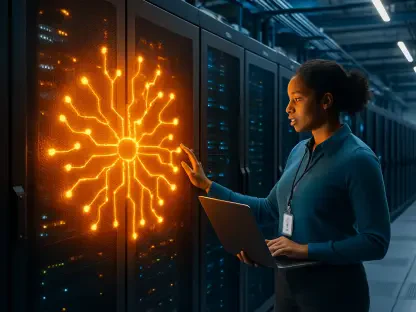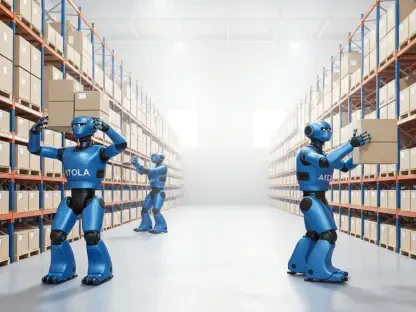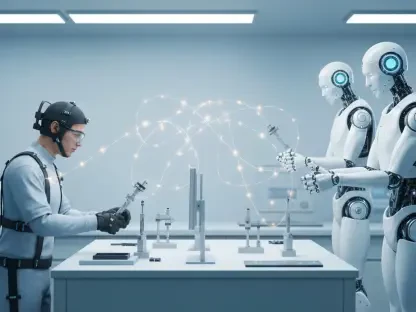Imagine a world where individuals with mobility challenges can effortlessly climb stairs or lift heavy objects, reclaiming independence through cutting-edge technology that transforms lives. This vision is rapidly becoming reality with the integration of artificial intelligence into wearable robotics, particularly exoskeletons. These devices, designed to augment human movement, are undergoing a transformative shift as AI enhances their adaptability and responsiveness. The wearable robotics industry stands at a pivotal moment, with AI-driven solutions paving the way for more intuitive support systems that cater to diverse user needs across multiple sectors.
At present, exoskeletons are gaining prominence in healthcare and rehabilitation, where they assist individuals recovering from injuries or coping with age-related mobility decline. The incorporation of AI marks a significant departure from traditional systems, which often relied on rigid, pre-programmed actions. By leveraging advanced algorithms and sensor technologies, these intelligent exoskeletons can now interpret user intent and environmental cues in real time, offering seamless assistance. This evolution is driven by research from leading institutions like the RIKEN Guardian Robot Project, which focuses on creating adaptive robotic solutions for practical use.
The scope of AI in this field extends beyond technical innovation, touching key areas such as elderly care and post-injury recovery. Major market players, alongside academic research bodies, are exploring how sophisticated sensor systems can refine movement prediction, while industries recognize the potential to enhance user independence. As AI continues to redefine wearable robotics, its applications promise not only to support physical tasks but also to empower users with greater autonomy in their daily lives, setting a new standard for assistive technology.
Innovations and Market Trends in AI Exoskeletons
Emerging Technologies and User-Centric Developments
The adoption of AI in exoskeletons is being propelled by groundbreaking trends that prioritize real-time adaptability. One notable advancement is the use of transformer models, a type of AI algorithm that processes complex data inputs to predict and adjust to user movements dynamically. This technology enables exoskeletons to respond instantly to varying physical demands, whether the user is navigating uneven terrain or performing routine tasks, thus ensuring a more natural interaction between human and machine.
Complementing these algorithms are innovative input systems, such as first-person cameras and kinematic sensors positioned strategically on the body. These tools provide a dual perspective—visual context of the surroundings and precise movement data—allowing the exoskeleton to offer context-aware assistance. Such developments address long-standing limitations in wearable robotics, making devices less cumbersome and more aligned with the user’s immediate environment, which is critical for practical application in real-world settings.
Consumer needs are also shaping these innovations, with a growing demand for intuitive solutions that minimize physical strain. Market drivers like aging populations and increasing rehabilitation requirements further fuel this trend, pushing manufacturers to design non-invasive, user-friendly devices. The opportunity to create scalable solutions for everyday mobility support is evident, as these technologies evolve to meet the diverse expectations of users ranging from elderly individuals to those in recovery, opening new avenues for widespread adoption.
Market Growth and Future Projections
The market for AI-powered exoskeletons, though currently a niche segment within assistive technology, is demonstrating robust growth. Recent estimates suggest a steady rise in demand, particularly in healthcare, where these devices are becoming integral to patient recovery programs. With an expanding user base, the industry is poised for significant expansion, driven by the need for effective solutions in elderly care and rehabilitation settings across global markets.
Looking ahead, projections indicate a substantial increase in market size from 2025 to 2030, as adoption rates climb in response to societal challenges like population aging. Forward-looking data also points to potential cost reductions through cross-user adaptable systems, which minimize the need for extensive customization. Studies show that such adaptability can lower barriers to entry, making these advanced tools more accessible to a broader audience and enhancing their commercial viability.
This growth trajectory is supported by technological advancements that promise to streamline production and integration processes. As investment in research and development continues, the industry anticipates a surge in innovative applications, positioning AI exoskeletons as a cornerstone of future assistive technologies. The focus remains on balancing performance with affordability to ensure these solutions reach those who need them most.
Challenges in Developing AI-Powered Exoskeletons
The development of AI-powered exoskeletons, while promising, faces several hurdles that must be addressed to achieve mainstream success. A primary limitation lies in the technological constraints of traditional exoskeletons, which often depend on pre-programmed motions lacking flexibility. This rigidity hampers their ability to adapt to unpredictable scenarios, underscoring the need for more dynamic systems capable of learning and responding to unique user patterns.
Beyond technical barriers, achieving seamless user interaction remains a complex endeavor. High development costs pose another significant challenge, as creating sophisticated AI models and integrating advanced sensors demand substantial resources. Additionally, accessibility issues persist, with many potential users unable to afford or access these cutting-edge devices, limiting their impact on a larger scale despite evident benefits in mobility support.
Solutions to these challenges are emerging, with AI offering potential for generalization across users, thereby reducing the need for time-consuming calibration. Efforts to lower production expenses through scalable designs and shared technology platforms also show promise. By focusing on cost-effective manufacturing and inclusive design principles, the industry aims to overcome these obstacles, paving the way for broader market penetration and enhanced user experiences.
Regulatory and Compliance Considerations
Navigating the regulatory landscape for wearable robotics requires careful attention to standards governing safety and efficacy, especially for devices used in medical and assistive contexts. Authorities worldwide have established stringent guidelines to ensure that exoskeletons meet rigorous performance criteria, protecting users from potential risks associated with malfunction or improper use. Compliance with these rules is non-negotiable for manufacturers aiming to bring their products to market.
In rehabilitation and elderly care, adherence to health and technology regulations is particularly critical, as these sectors involve vulnerable populations. Regulatory bodies emphasize the need for thorough testing and validation to guarantee device reliability under diverse conditions. This focus on compliance not only safeguards users but also shapes the pace of innovation, as developers must align their advancements with evolving legal frameworks.
The impact of regulatory changes on market entry cannot be understated, often influencing the speed at which new technologies are adopted. Additionally, the integration of AI raises concerns about data security, given the sensitive nature of user information processed by these systems. Ensuring robust protection mechanisms is essential to maintain trust and meet compliance requirements, highlighting the importance of secure design in the development of intelligent exoskeletons.
Future Horizons for AI Exoskeletons
Looking toward the future, AI-powered exoskeletons hold the potential for remarkable breakthroughs, particularly in achieving fully autonomous assistance systems. Innovations in machine learning are expected to drive personalized mobility support, enabling devices to tailor their responses to individual user profiles with unprecedented precision. Such advancements could redefine how physical assistance is delivered, making it more effective and less intrusive.
Emerging competitors and affordability initiatives may act as market disruptors, challenging established players to innovate further. Shifting consumer preferences toward non-invasive, user-friendly designs are likely to influence product development, pushing for solutions that blend seamlessly into daily life. The industry must also contend with global aging trends and economic conditions, which will shape demand patterns and investment priorities in the coming years.
Several factors, including innovation incentives and collaborative research efforts, are set to define growth areas in healthcare and beyond. As economic landscapes evolve, the focus on scalable technologies could unlock new applications, from industrial settings to personal mobility aids. The trajectory of AI exoskeletons suggests a dynamic future, where continuous improvement and adaptability remain central to meeting the needs of an ever-changing user base.
Conclusion and Path Forward
Reflecting on the journey of AI-powered exoskeletons, the industry has witnessed remarkable strides in enhancing mobility and independence for diverse populations. The exploration of transformative technologies and market trends has revealed a clear path of progress, underscored by measurable reductions in physical strain during everyday tasks. Scalability through cross-user adaptability has emerged as a pivotal achievement, broadening the reach of these innovative tools.
Moving forward, actionable steps include prioritizing investment in scalable technologies to drive down costs and expand access. Stakeholders are encouraged to explore expanded applications in rehabilitation and elderly support, leveraging collaborative partnerships to accelerate development. Continued research must focus on refining user interaction and ensuring regulatory alignment, setting the stage for intelligent exoskeletons to make a lasting impact on quality of life across global communities.









